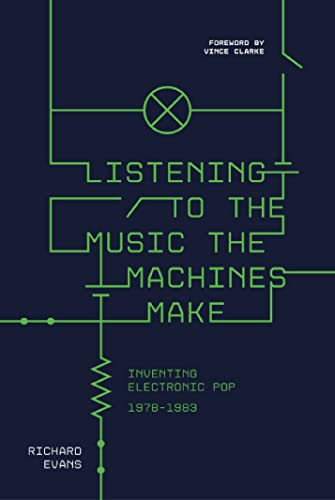 Listening to the Music the Machines Make by Richard Evans
Listening to the Music the Machines Make by Richard Evans
Out now on Omnibus Press
November 2022 saw the release of ‘Listening to the Music the Machines Make’ written by Richard Evans. This substantial tome traces the revolution of electronic music from key years 1978, through to 1983. Pulled together from archive press materials, quotes from previously released biographies, intensive research and forensic attention to detail, the book follows the chronological evolution and truly organic rise of electronic music.
Using 1978 as a starting point, Evans embarks on documenting the rich history of electronic music by wading through the ashes and debris of punk (Sex Pistols being the main talking point) and glam rock. However, before that, the book starts with a prologue chapter entitled ‘Inspiration’ 1977 where David Bowie’s music and legacy acts as the main reference point. Discussing Bowie’s career and influence through the eyes and ears of key players such as Bernard Sumner, Andy Muclusky, Jim Kerr, etc, the chapter traces the impact that Bowie (also Roxy Music) had on the formative years of these musicians. The fact that Bowie reappears throughout this book is a testament to the great man himself.
Using punk to start this story and the journey really illustrates the organic way that electronic music started and evolved throughout the late 70s and early 80s from this movement. Instead of using guitars as rudimentary instruments played with (in some cases) the bare minimum of talent, the artists that previously pogoed in clubs, jumped on the chance of obtaining cheap synthesizers and using them in that same rudimentary way. Building on the influences coming from Germany (Kraftwerk, NEU!, etc), these musicians took the same punk energy and moulded it into something altogether different, whilst never losing the energy.
What this book excels at is the forensic way that Evans has pieced the story/evolution/movement of this genre through archived press quotes and reviews from the main music papers of the time. These reviews and opinions of journalists at the time really did both help and hinder the acts throughout this period. Through concentrating on the minutiae throughout this period and beyond, the book brilliantly documents the way that the music industry changed and how the bands changed with it. Technology, Labels, CDs, MTV, the demise of the music papers, glossy magazines, fashion, all feature throughout the book, and how the bands dealt with this fast-changing landscape is extensively described across the 500+ pages.
The book ends with an epilogue chapter entitled ‘Reaction’ 1984 – 1993. This last chapter details the rise of the rave scenes, Acid House, bands like Orbital, The KLF, The Prodigy, and also the influences coming from the USA like the Chicago House scene (in particular it’s influence on New Order), Afrika Bambaataa, etc, through to the beginnings of the industrial scene with Einstürzende Neubauten, Ministry, NIN, Front 242, etc.
Featuring additional input from key figures, including Vince Clarke (Depeche Mode, Yazoo, Erasure), Martyn Ware (The Human League, B.E.F., Heaven 17) and Daniel Miller (The Normal, Mute Records), this book is a welcome addition to the existing literature. The bands that feature (Joy Division, Throbbing Gristle, Human League, etc) may have been written about extensively previously (there’s also plenty of bands and music to discover if you aren’t particularly au fait with this period), but it’s the way that Evans weaves and knits these familiar names into such a rich and enormous tapestry that makes the book stand out. It is also done with humour and an affable tone that adds a human touch to the academic, and again, forensic approach taken. Plus, it’s so bloody lovely to immerse oneself into this utterly fascinating and key period in the evolution of electronic music once again and realise how important it is.
Ending the story in 1993, as a reader (and music fan) I was left wanting more. There is another tapestry waiting to be weaved from 1993 to present day. More music, less big labels and more DIY, and of course, the rise of social media. Extraordinary changes have happened since 1993, so I’m hoping that Evans is busy writing tome #2…
Highly recommended.
About the author: Richard Evans has worked in the music industry for over thirty years in a variety of roles, including positions at London Records, Factory Records and MTV Europe. In 1998 he set up marketing consultancy The Fan Base and has been connecting musical artists with their audiences ever since. He is the founder of the This Is Not Retro website and record label and has worked for Andy Bell, Vince Clarke and Erasure since 2009.
~
Words by Ioan Humphreys. More writing by Ioan can be found at his author’s archive.
We have a small favour to ask. Subscribe to Louder Than War and help keep the flame of independent music burning. Click the button below to see the extras you get!
SUBSCRIBE TO LTW





